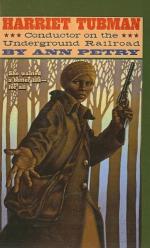
|
| Name: _________________________ | Period: ___________________ |
This test consists of 5 multiple choice questions, 5 short answer questions, and 10 short essay questions.
Multiple Choice Questions
1. Who was the United States Commissioner who presided at Thomas Sims’s hearing?
(a) George Ticknor Curtis.
(b) Thomas Sims.
(c) Peter Jackson.
(d) John Campbell Henry.
2. When was Thomas Sims arrested, according to the author in Chapter 13: “The Legend of Moses”?
(a) March 11, 1852.
(b) April 3, 1851.
(c) June 22, 1847.
(d) October 14, 1854.
3. Harriet told the slave refugees that William Garrett would give everyone what when they arrived in Chapter 14: “The Railroad Runs to Canada”?
(a) Blankets.
(b) Bread.
(c) Water.
(d) Shoes.
4. What runaway slave was arrested and going to trial on April 27, 1860, according to the author in Chapter 21: “With the Union Army”?
(a) Mingo Harth.
(b) Nat Turner.
(c) Charles Nalle.
(d) John Tubman.
5. On what date did Reverend Theodore Parker write a letter to Millard Fillmore in Chapter 12: “Freedom’s Clothes”?
(a) June 3, 1846.
(b) November 21, 1850.
(c) August 7, 1852.
(d) April 28, 1856.
Short Answer Questions
1. Who shot Abraham Lincoln?
2. Benjamin Ross was described in the records as being how old in Chapter 17: “Moses Arrives with Six Passengers”?
3. What was the name of the horse that Harriet stole in order to help her parents flee in Chapter 19: “The Old Folks Go North”?
4. How old was John Chase described as in the records in Chapter 17: “Moses Arrives with Six Passengers”?
5. Who said in Chapter 18: “A Wagon Load of Bricks,” “I’ll wade no freezin’ water for no crazy woman”?
Short Essay Questions
1. What slave story does the author relate that took place in Boston in Chapter 13: “The Legend of Moses”?
2. In what capacity did Harriet serve the Union Army during the Civil War?
3. What threat of violence did Harriet make against one of the slaves in Chapter 15: “Go On or Die”? Why?
4. At whose urging did Harriet begin speaking publicly, according to the author in Chapter 20: “The Lecture Platform”? When and where did this occur?
5. What was Harriet’s objective in returning to Maryland in Chapter 16: “Be Ready to Step on Board”? How did she remit word that she would be arriving?
6. What was Harriet’s trip North in Chapter 18: “A Wagon Load of Bricks” more difficult than her previous trips? How did she succeed in crossing the river?
7. What happened to Jacob Jackson’s letter in Chapter 16: “Be Ready to Step on Board”? How did he respond to the situation?
8. What slave story does the author relate in her historical note at the end of Chapter 16: “Be Ready to Step on Board”?
9. How many trips did Harriet Tubman make to Maryland between 1851 and 1857, according to the author in Chapter 18: “A Wagon Load of Bricks”? Who was she rescuing in November of 1856?
10. What speech of Abraham Lincoln’s is described in the author’s historical note at the end of Chapter 21: “With the Union Army”?
|
This section contains 884 words (approx. 3 pages at 300 words per page) |

|




